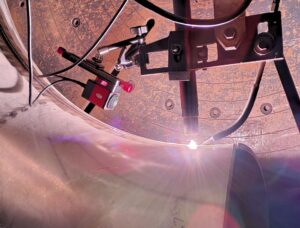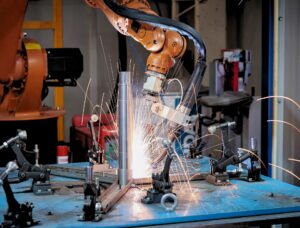Weld quality doesn’t start with the arc—it starts with your base metal. No matter how skilled a welder is or how advanced the welding equipment may be, if the base metal isn’t properly prepared, the final weld is at risk of porosity, lack of fusion, slag inclusion, and even failure. Whether you’re doing MIG welding, TIG welding, or metal arc welding, preparation is a critical first step to ensure integrity, strength, and longevity. In this article, we’ll explore the three most important base metal preparation steps—cleaning, beveling, and checking for contaminants—and discover why prepping your base metal is crucial for strong welds, and how welding cameras and inspection tools can help you monitor the results.
1. Cleaning: Removing Surface Contaminants That Cause Weld Defects
Oil, paint, mill scale, rust, and moisture can all interfere with weld formation. Contaminants cause porosity, inclusions, and incomplete fusion, especially in TIG (Tungsten Inert Gas) and MIG welding processes.
Best Practices:
- Degrease using acetone or other non-residue solvents.
- Mechanically clean the surface using a grinder or wire brush (use stainless brushes for aluminum).
- Avoid moisture exposure after cleaning—weld promptly.
Tip: Use a welding camera or weld monitoring system to observe arc stability. Irregular arcs or spatter patterns can be early indicators of unclean base metal.
2. Beveling and Edge Preparation: The Foundation of Joint Penetration
For thicker materials (typically over 3/16 inch or 5 mm), simply placing two square edges together won’t allow the weld to penetrate fully. Beveling the edges ensures proper fusion deep into the joint.
Common Bevel Types:
- V-Groove
- J-Groove
- Double V or Double U (for thick plates)
Proper beveling:
- Increases surface area for the weld
- Reduces the chance of weld defects like incomplete penetration
- Promotes better weld bead placement and strength
Plasma arc welding and metal arc welding of structural steel heavily rely on precise beveling. Integrating a welding camera manufacturer’s system into your welding workflow can help ensure proper joint fit-up and filler material distribution.
3. Checking for Hidden Contaminants: Moisture, Oxides, and Residual Coatings
Even when metal looks clean, hidden issues can linger—especially on metals like aluminum, which develops a tough oxide layer that doesn’t melt at the same temperature as the base metal.
Inspection Techniques:
- Use a welding inspection tool to check for oxide buildup or residual coatings.
- Consider chemical cleaning or etching for certain metals like stainless steel or aluminum.
- For field welds, visually inspect and photograph surfaces using welding visual inspection cameras before beginning.
For critical applications like pipeline welding, aerospace TIG welding, or robotic welding in automotive production, even minor surface contamination can lead to weld failures or expensive rework.
How Weld Monitoring Cameras Enhance Preparation and Quality
Welding cameras offer a major advantage during setup and execution:
✅ Visual Feedback: High-definition arc welding images allow operators to assess weld behavior and arc focus in real time
✅ Alignment Confirmation: Monitor joint fit-up and base metal prep without halting production
✅ Heat Input Tracking: Prevent overheating cleaned edges or burning through improperly beveled joints
✅ Confined Space Access: In hard-to-see or remote locations, cameras reveal surface condition before welding begins
Combined with welding inspection techniques, modern weld monitoring systems are essential for quality assurance and repeatable welds.
Conclusion: Why Prepping Your Base Metal Is Crucial for Strong Welds
Skipping base metal preparation is like painting over dust—it may look fine at first, but it won’t last. From removing oil and rust, to beveling thick edges, to checking for invisible contaminants, proper preparation ensures your weld is set up for strength and success.
Integrating a welding camera system into your workflow adds a second set of eyes—capturing real-time visuals, helping you validate surface conditions, and improving your welding quality every step of the way.
Ready to upgrade your welding quality control? Contact Mecaweld today to learn how our weld monitoring cameras and inspection systems help you catch problems before the arc strikes.



